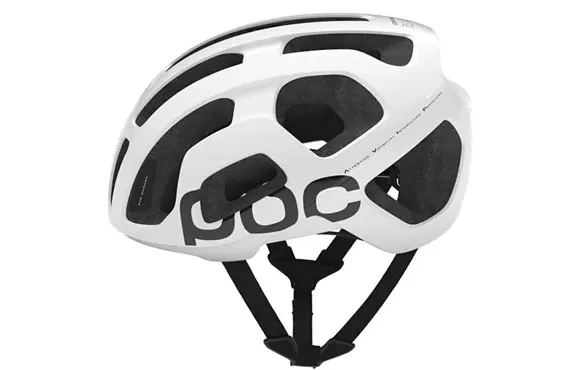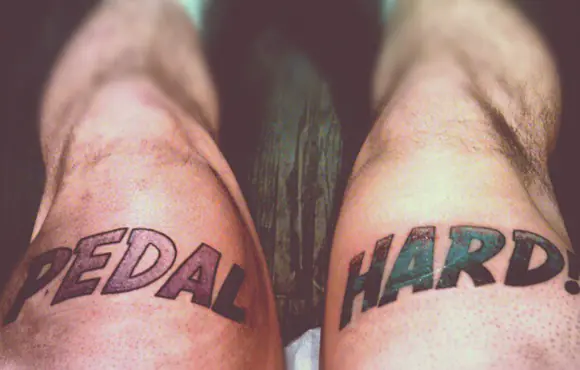Check out these four new helmets, some of the fastest and most comfortable available on the market today.
Smith Overtake
$250 (without MIPS) 1 of 9
Most cycling helmets are made primarily of EPS foam. The foam not only creates the shape of the helmet, but also absorbs the energy of an impact. Smith's Overtake still uses some EPS to create the shape and structure of the helmet—but it also includes a shock-absorbing material called Koroyd.
Koroyd is described by its manufacturer as "copolymer extruded tubes" thermally welded together to create a honeycomb-like material. According to Smith, in an impact, Koroyd absorbs 30 percent more energy than EPS foam. And for an extra $40, the Overtake is offered with an optional MIPS rotational force reduction system. With MIPS and Koroyd, the Overtake is an impressively safe helmet—at least on paper. As with all safety technology, it's difficult to know how effective the technologies will be in a real-world incident.
Koroyd's hollow tubes allow airflow, so one of the helmet's major benefits, according to Smith, is improved energy absorption with much greater breathability than helmets made solely of EPS foam. An inside view of the helmet reveals that the areas that contact the rider's head are primarily made up of Koroyd.
In theory, providing opportunities for heat to escape (i.e. vents) makes for a cooler helmet. The Overtake, with its layers of honeycombed Koroyd placed in the spaces where there would typically be vents, doesn't vent well, but it does breathe well. When you're riding, you don't feel the air blasting your forehead and rushing over your scalp the way it does in well-ventilated road helmets, or even in many aero helmets like the Evade. At stoplights and coffee shops, the Overtake's breathability becomes more apparent; it feels like there's less heat build-up inside the helmet. But the breathability doesn't translate to a significant cooling benefit at speed. It's not bad, but you'll find better ventilation in Giro's $65 Foray helmet (though without the potential safety and aerodynamic benefits of the Overtake).
Smith Overtake Continued
$250 2 of 9
Filling the "vents" with Koroyd has some interesting side effects. If you ride off-road, you no longer have to worry about bees in the helmet or branches poking in. But it does complicate sunglasses docking. The temples of many glasses will drop into the upper vent halo, but the temples need to be on the thin and straight side. Smith's Pivlock and Overdrive glasses drop right in; so do Oakley Radar/Radar Lock and Jawbone. Taller, curved temples, like those on the Assos Zegho, don't work well. But just because the temples drop into the groove doesn't mean they're secure. Ironically, the Oakleys are far less likely to shake loose than the Smith glasses. If docking your glasses up top is important to you, double-check in person that your glasses will ride securely by sticking them on the Overtake and giving it a shake.
Though it's not immediately apparent by looking at the helmet, Smith says the Overtake has some aerodynamic optimization, claiming that it's 1.06 seconds slower than a Specialized Evade aero helmet but 4.15 seconds faster than a Giro Air Attack (time saved over a 40 km time trial at a constant 40 kph). Like any other aero road helmet claim, this is very difficult to prove in real-world riding conditions.
The Overtake is a comfortable helmet to wear, with a head shape that's almost identical to the popular Giro Aeon. Smith's Vaporfit fit system is non-intrusive and effective, with an easy-to-use two-way dial. Smith uses adjustable webbing splitters for further customization (I'm seeing more helmet makers going with fixed splitters), which lock securely and don't creep. The webbing is thin and doesn't absorb much liquid, but feels a little stiff and scratchy against the skin when dry. The interior padding is soft and comfortable. My size medium, which did not have the MIPS option, weighed 271 grams. Not heavy, but also not light.
Price: $250 without MIPS
Weight: 271g (M)
Sizes: Small, medium, large
Info: smithoptics.com
POC Octal MIPS
$320 3 of 9
As a brand, POC started with safety gear, and though the company's product line continues to grow into apparel and other goods, the focus on safety continues. Even POC's road cycling apparel is designed to improve safety by making the wearer appear not just brighter, but more easily identifiable as a cyclist.
It's no surprise, then, that POC was one of the earliest brands to champion and incorporate the MIPS rotational force reduction system. This adds $50 to the price of the helmet and 20 grams. Although it's impossible to user-test the effectiveness of the MIPS system, it's designed to reduce friction between the helmet and the skull during an angled impact. The system works much like the brain's own cushioning layer of cerebrospinal fluid and helps protect against injuries caused by rotational acceleration (e.g. concussions).
The system is a thin layer of plastic anchored by rubber straps that allows the helmet to slip independently of the skull in angled impact—MIPS says most real-world impacts occur at an angle rather than straight-on. It's very light and almost invisible: swap between a MIPS and non-MIPS version of the Octal and you'd be hard pressed to notice a difference—but your brain will notice, in the event of an angled impact. POC's MIPS upgrade is $50—more than double the price of the MIPS upgrade in a Giro or Bell helmet ($20)—but still worth the peace of mind. Given the minor weight, cost, and minimal fit/function penalty, I'd choose the MIPS option with my brain on the line.
The Octal's construction is unique. The unibody polycarbonate shell provides the helmet's structure—instead of high-density foam or an internal skeleton—allowing POC to use a lower-density foam for impact protection. In a crash, lower-density foam absorbs more energy, so less of it is transmitted to the rider's skull, making for a safer helmet. The tradeoff is that a low-density foam-based helmet requires a larger total amount of foam, which results in a thicker, chunkier-looking helmet.
POC Octal MIPS Continued
$320 4 of 9
Other features include eye-catching colors, reflectivity, and an ICEdot tag that can be set up to provide emergency responders with the wearer's identity and health data.
The Octal's shape is on the round side, nearly indistinguishable from Giro's. The straps use the single-layer, lightweight webbing that's finding its way into many high-end helmets. It's comfortable and doesn't absorb much sweat. The Octal's strap splitters look fixed on first glance, but are adjustable, albeit with some difficulty. Similar to a Specialized Prevail, the strap anchor points are on the outboard edges of the helmet, which lessens contact with the skin. Though I like the reduced contact, I find the outboard placement causes the helmet to rock more on my head (I have this issue with the Prevail also), and it feels less secure than helmets with interior strap anchors.
POC's head gripper system is height-adjustable, and size-adjustable with a two-way dial. The system isn't remarkable, but it is effective, and the components are small and unobtrusive. The Octal does cover a bit more of the back of the head than a typical road helmet. Nothing wrong with that, though I did notice it nearly interfered with the temples of my Oakley Radarlock glasses. POC's padding is perhaps the nicest I've experienced.
Ventilation is very good, among the best I've tried. A nice blast on the forehead, with significant air rippling though my hair—great for a heavy sweater like myself. The vents are big, so there's plenty of room to stuff in sunglasses, but glasses don't perch as securely as I'd like, despite sticky "Eye Garage" pads in the vents. It works in a pinch, but if you stash your glasses a lot, this might not be the helmet for you.
POC Octal MIPS Continued
$320 5 of 9
At 270 grams with MIPS, the Octal fits into the not-light-but-not-heavy zone of high-end road helmets. That's not a bad place to land considering the additional weight of MIPS, and it's worth noting that the Octal with MIPS is the same weight as a Smith Overtake without it.
I try to avoid discussions of styling, since my definition of beauty is probably as complicated and personal as yours. I'm of the opinion that all helmets look kind of silly, so arguing that a Giro Air Attack is somehow less attractive than a Specialized Prevail seems ridiculous. The Octal does seem to elicit a strong binary response, however: it's either loved or hated. I did notice that, both in my hands and on my head, the Octal has a somewhat blocky, squared-off look that contrasts with the flowing points typical of most helmet designs. It also looks a bit big, though this may be an inescapable effect of having more foam between my skull and the road, which, in a crash, is a good thing.
Weight: 270g with MIPS (M)
Price: $320
Sizes: Small, medium, large
Info: pocsports.com
Kask Protone
$300 6 of 9
Aero helmets are getting better-looking. Viewed from the front, the Protone looks like a typical road helmet with lots of vents, albeit a rather flashy one. But from the rear, the Protone reveals its wind-cheating intentions. Designed with input from the Sky racing team, Kask says the Protone "has among the fastest heat dissipations and lowest drag coefficients of any ventilated helmet." Slippery and cool sounds great; however, no accompanying data was provided to support those claims.
The Protone has details typical of the brand's high-end offerings. Most noticeable is the "Eco-leather" chinstrap, which I find more comfortable on the skin than a webbing chinstrap in most conditions. I do think lightweight webbing is superior in very hot weather because it wicks sweat better. Inside the helmet, Kask uses its own open-cell 3D Dry pads in some, but not all, padding locations. This multi-layer pad has a "drilled" first layer that the company claims reduces contact with the head by 70 percent, for better breathability. It may work, but I can't say the difference is obvious.
Kask Protone Continued
$300 7 of 9
Like many fit systems, Kask's Octo Fit head gripper system is adjustable for tension using a dial, and is also height-adjustable. More intricate than most are the cups that grab the back of the head: these are independently adjustable laterally, and can twist axially to conform to the contour of the user's head. I've tried a lot of fit systems, and this one provides the most customized feel of any. If there's a drawback, it's that it wraps well forward and compromises the fit of some sunglasses (I had no issues with my Oakley Radarlocks). The inside shape of the Protone is perhaps a bit rounder than that of a comparable Giro, and the lightweight webbing has fixed splitters. In general, I'm suspicious of fixed splitters because they remove an adjustment that can be used to fine-tune fit, but the webbing happened to be perfectly positioned for me.
Between the plush padding, leather-like chin strap, thin webbing and excellent head gripper, I found the Protone extremely comfortable, and free of any hot spots during long rides. Airflow is good on the forehead with plenty of air being drawn out the back. Overall, ventilation is definitely "aero-road helmet 2.0": better than a Specialized Evade or Giro Air Attack, if not quite as good as the best ventilated road helmets. Since I sweat a lot and like to stash my sunglasses on long, slow climbs, how easily and securely a helmet can hold glasses in its vents matters to me. The Protone is one of the best I've found for that, holding several different types of glasses securely. Kask even claims they intentionally designed the helmet so drag does not increase with glasses stashed in the vents.
Kask Protone Continued
$300 8 of 9
My review helmet was a prototype and likely a CE (European) version—which tend to be lighter than CPSC helmets that are approved in the US due to the different test protocols—and weighed 231 grams. I'd expect CPSC versions to be heavier.
Using the Protone, I was reminded a lot of the Giro Synthe. They're both medium-light helmets that look relatively "normal," vent very well, and fit comfortably. If we stopped right there, we'd have a great helmet. Both also supposedly save you some energy, which is the primary hook of these helmets. From my perspective as a user, the aero benefit is a cherry on top, as they're both helmets I'd wear regularly, even if they had the aero drag of a normal road helmet.
Weight: 231g, pre-production sample (M)
Price: $300
Sizes: Medium, large
Info: kask.it







Discuss This Article